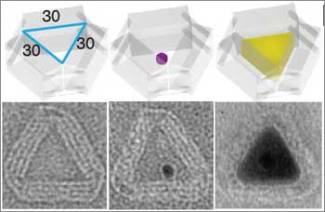Research conducted at Harvard University has helped to develop a new method for casting 3D custom-shaped metal nanoparticles using DNA as construction moulds.
 By creating molds from stiff DNA, researchers were able to cast gold "seeds" into complex metal nanoparticles. From left to right, this 3D polygonal particle was formed by designing a DNA mold, planting a gold seed, then chemically forcing the seed to expand until complete formation. Credit: Harvard's Wyss Institute
By creating molds from stiff DNA, researchers were able to cast gold "seeds" into complex metal nanoparticles. From left to right, this 3D polygonal particle was formed by designing a DNA mold, planting a gold seed, then chemically forcing the seed to expand until complete formation. Credit: Harvard's Wyss Institute
Stiff DNA was used by researchers at the Wyss Institute for Biologically Inspired Engineering in order to form metal nanoparticles in the desired design and shapes.
This new method could aid in the advancement of disease detection, electronics, environmental testing, solar cells, microscopy and other applications. The study advances DNA nanotechnology and inorganic nanoparticle synthesis.
The researchers used computer design software to design the 3D inorganic nanoparticles. They then used linear DNA sequences in order to design and build 3D frameworks. These sequences were then used to bind to each other in a specific predictable pattern.
Previously, researchers have used different techniques in order to produce 3D shapes from DNA.
This allowed the Wyss researchers to use DNA structures as moulds for materials such as silver and gold.
Tiny gold seeds were placed inside specific cube–shaped DNA moulds. An activating chemical solution was used to stimulate the growth of these seeds, which grew to fill the space in the DNA framework with the shape and dimensions of the mould. Many different types of 3D sphere, polygons and other complex shapes were also created.
The study revealed that the DNA moulds were strong, robust and were able to endure the pressures exerted by the inorganic materials when they were expanding.
The DNA mould’s framework was retained by the nanoparticles as an outer coating after they were cast. This enabled further modification of the surface with very high nanoscale range precision. This coating holds promise for potential applications for early detection of cancer and genetic diseases.
The DNA’s chemical specificity is combined with the metal’s signal readout for these applications. In addition, the DNA framework coating can also be broken down for production of metal connectors and wires for applications in electronic circuitry and nanocomputers. This study has been published in the journal Science.